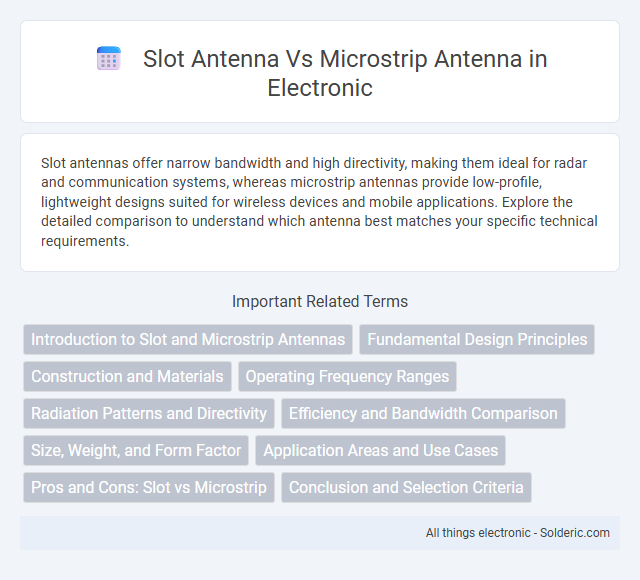Slot antennas offer narrow bandwidth and high directivity, making them ideal for radar and communication systems, whereas microstrip antennas provide low-profile, lightweight designs suited for wireless devices and mobile applications. Explore the detailed comparison to understand which antenna best matches your specific technical requirements.
Comparison Table
| Feature | Slot Antenna | Microstrip Antenna |
|---|---|---|
| Structure | Slot cut in a metallic surface | Conductive patch on dielectric substrate |
| Radiation Pattern | Broadside or end-fire | Broadside directional |
| Bandwidth | Typically narrow | Moderate to narrow |
| Polarization | Linear (depends on slot orientation) | Linear or circular (with design) |
| Size | Compact, depends on slot length | Compact, depends on patch size |
| Efficiency | High due to metallic ground plane | Moderate, affected by dielectric losses |
| Applications | Radar, satellite, microwave systems | Wireless communications, GPS, mobile devices |
| Manufacturing | Requires precise slot cutting | Printed circuit techniques |
Introduction to Slot and Microstrip Antennas
Slot antennas feature a slot cut into a conductive surface, radiating electromagnetic waves through the aperture with high efficiency and wide bandwidth. Microstrip antennas consist of a metallic patch on a dielectric substrate, offering compact size and ease of fabrication for various applications. Your choice between the two depends on factors like frequency, bandwidth, and integration requirements in wireless communication systems.
Fundamental Design Principles
Slot antennas operate by creating radiation through slots cut into a conductive surface, utilizing the aperture as the main radiating element, whereas microstrip antennas rely on a patch element over a grounded substrate that radiates through fringing fields. The fundamental design principles of slot antennas emphasize the slot shape, size, and placement on the ground plane to control resonant frequency and radiation pattern, while microstrip antenna design focuses on patch dimensions, substrate dielectric constant, and thickness to optimize bandwidth and gain. Your choice depends on factors like desired polarization, frequency range, and physical integration constraints, as these parameters directly influence the antenna's performance characteristics.
Construction and Materials
Slot antennas are typically constructed by etching a rectangular or circular slot into a metallic plane, often made from copper or aluminum, providing a simple yet durable structure. Microstrip antennas consist of a patch conductor mounted on a dielectric substrate with a ground plane beneath, utilizing materials such as FR4, Rogers, or Teflon for optimal performance. Your choice depends on required bandwidth, fabrication ease, and application-specific factors like size and flexibility.
Operating Frequency Ranges
Slot antennas typically operate at microwave frequencies ranging from 1 GHz to 40 GHz, making them suitable for radar, satellite, and wireless communication applications. Microstrip antennas function effectively within a similar microwave frequency spectrum, commonly between 2 GHz and 18 GHz, but can be designed for frequencies up to 100 GHz in millimeter-wave bands. The choice between slot and microstrip antennas depends on frequency requirements, with slot antennas favored for higher frequency ranges and better bandwidth performance.
Radiation Patterns and Directivity
Slot antennas typically exhibit broadside radiation patterns with moderate directivity, making them suitable for applications requiring wide angular coverage. Microstrip antennas produce more defined radiation patterns with higher directivity, often focused in a specific direction, enhancing gain and efficiency in targeted communication systems. The choice between slot and microstrip antennas depends on the required radiation pattern shape and directivity for optimal system performance.
Efficiency and Bandwidth Comparison
Slot antennas typically offer higher efficiency compared to microstrip antennas due to their lower conductor and dielectric losses, making them suitable for high-power applications. Microstrip antennas generally provide wider bandwidth options when designed with techniques like stacked patches or innovative feeding methods, enhancing frequency flexibility. Your choice depends on whether efficiency or bandwidth is a priority for your specific communication system requirements.
Size, Weight, and Form Factor
Slot antennas typically offer a thinner profile and reduced weight compared to microstrip antennas, making them ideal for compact, lightweight applications. Microstrip antennas, while slightly bulkier due to their layered substrate design, provide greater flexibility in form factor customization and ease of integration with printed circuit boards. Your choice between these antennas should consider the trade-offs in size and weight relative to the specific spatial constraints of your project.
Application Areas and Use Cases
Slot antennas are widely used in radar systems, satellite communications, and wireless networking due to their wide bandwidth and high power-handling capabilities. Microstrip antennas find applications in mobile devices, GPS systems, and aerospace telemetry where compact size, low profile, and ease of integration with printed circuit boards are critical. Your choice depends on specific application requirements such as frequency range, radiation pattern, and form factor constraints.
Pros and Cons: Slot vs Microstrip
Slot antennas offer high bandwidth and better performance at high frequencies but tend to have larger size and more complex fabrication compared to microstrip antennas. Microstrip antennas are compact, low-profile, and easy to manufacture, making them ideal for integration into devices, though they generally suffer from narrow bandwidth and lower efficiency. Your choice depends on the application's frequency requirements, size constraints, and manufacturing capabilities.
Conclusion and Selection Criteria
Slot antennas offer wide bandwidth and good polarization diversity, while microstrip antennas provide compact size and ease of integration with planar circuits. Your selection depends on application-specific factors such as required frequency range, size constraints, radiation pattern, and manufacturing complexity. Consider slot antennas for high-power and broadband needs, whereas microstrip antennas suit compact, low-profile systems.
slot antenna vs microstrip antenna Infographic

 solderic.com
solderic.com